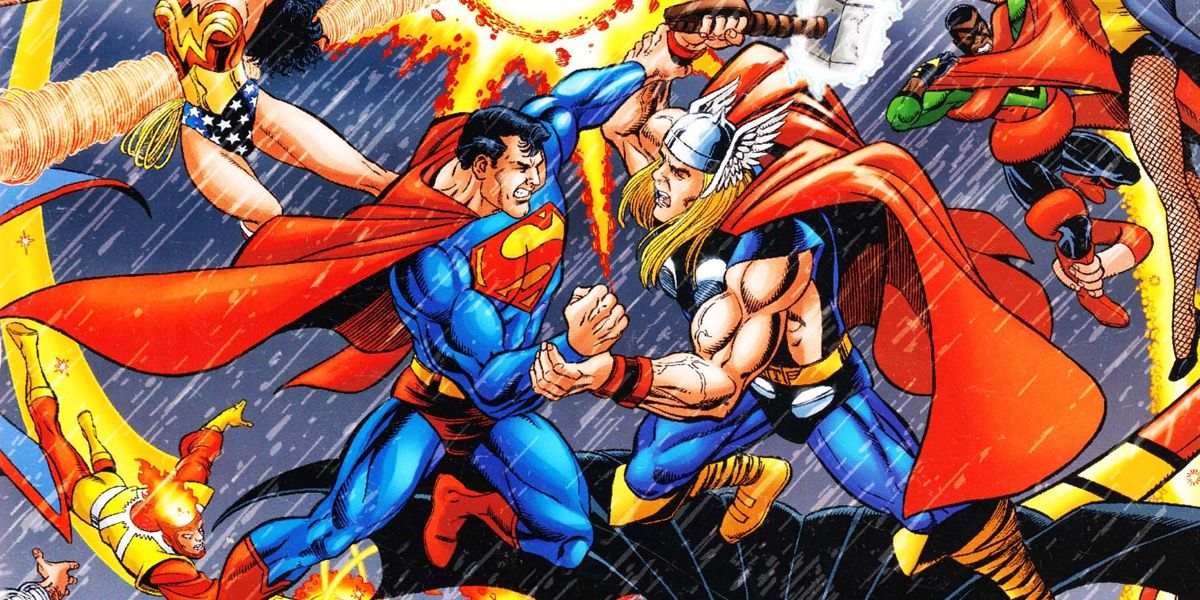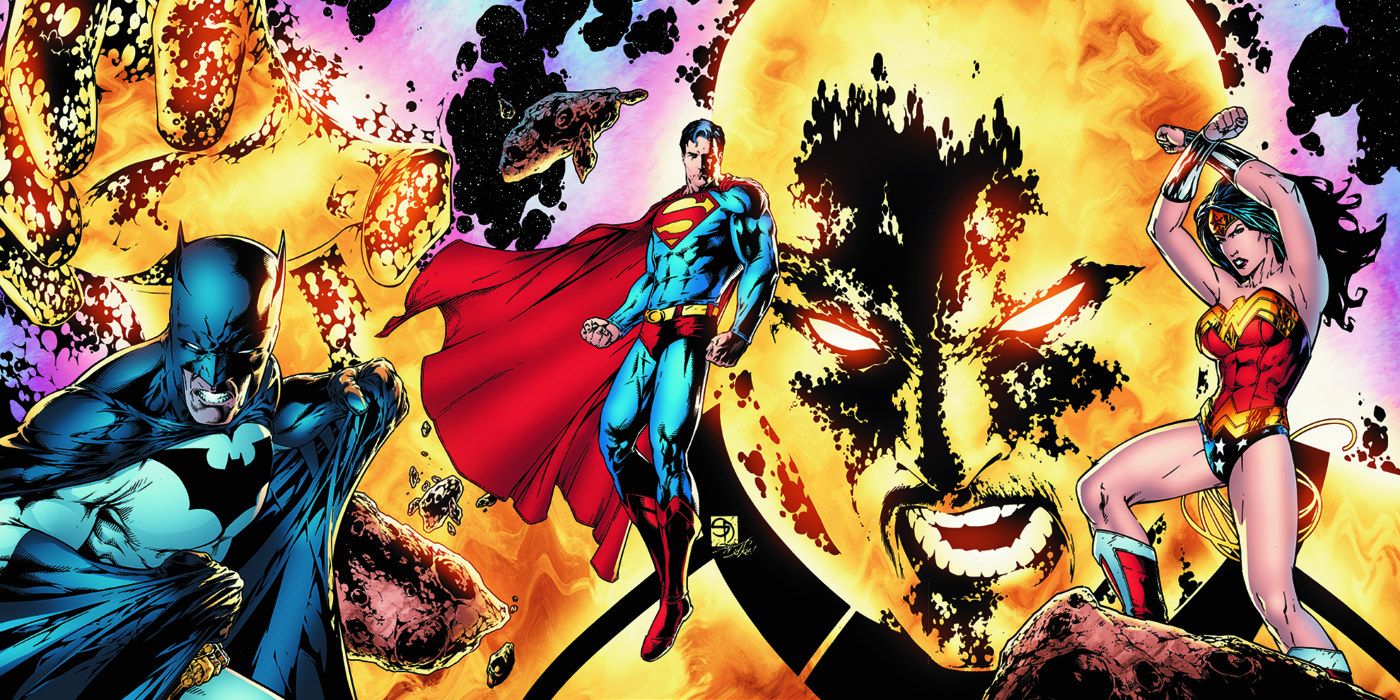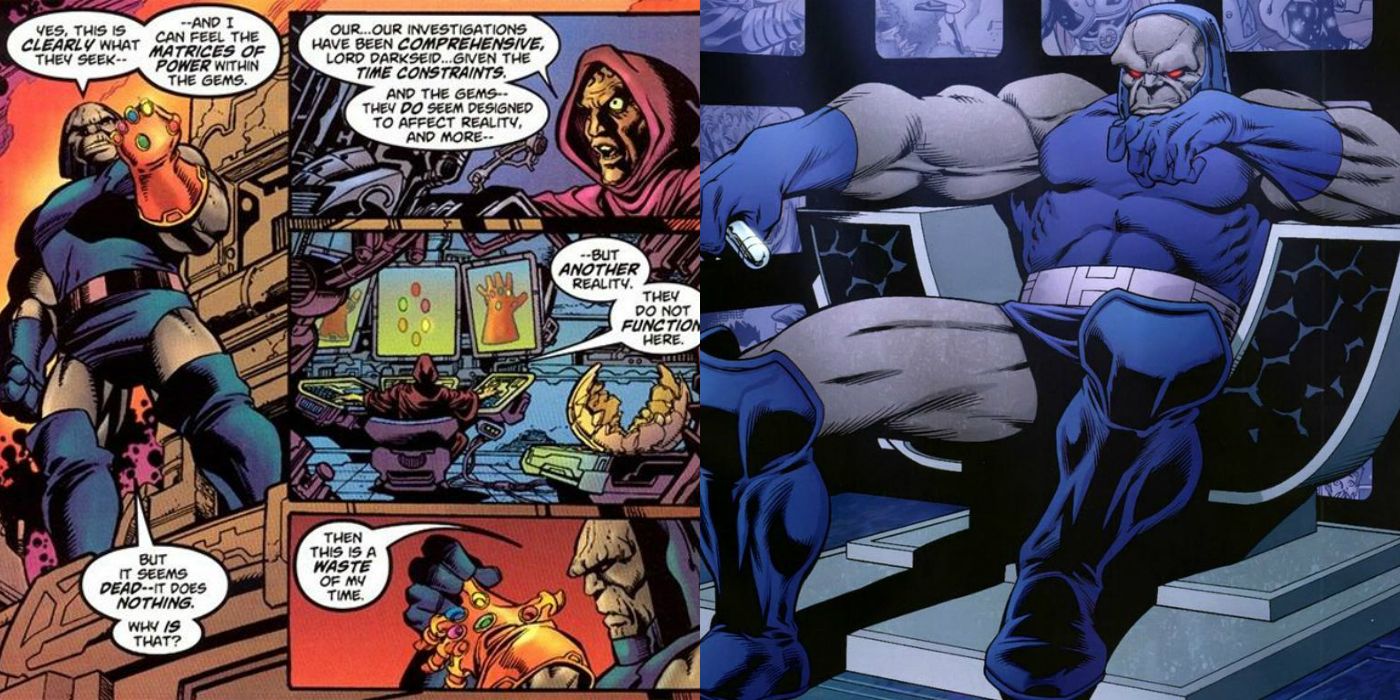In 2003 Kurt Busiek and George Pérez created a series that would fulfill the dreams of millions of comic book fans, teaming up DC’s Justice League with Marvel’s Avengers. But was this JLA/Avengers crossover technically canon? The answer is more complicated than fans might think.
Coming off of Busiek and Pérez’ collaboration on The Avengers, the crossover JLA/Avengers was a tribute to everything fans love about superhero comics. With a plot that took its heroes from the dinosaur-populated Savage Land to the even stranger inhabitants of Monster Island to a fortress made from the armor of Galactus, it brought together nearly every character either company had ever published.
The cover to issue #3 alone might be Pérez’ masterwork, including every single hero who had ever been on any incarnation of either team, somehow unifying that chaotic mass of characters into a geometric order, a work so intricate Pérez literally injured himself creating it.
A Story Too Big For Just Marvel or DC

The artwork and story is packed full of all the geeky goodies you could ever expect from this kind of mashup, from Wonder Woman arm wrestling Wonder Man, to Dr. Doom imprisoned in the Source Wall, to Mar-Vell and Shazam both responding to “Captain Marvel” at once, to Superman wielding both Thor’s hammer and Captain America’s shield. And that’s on top of the plentiful inside jokes Busiek draws from across both teams’ histories. Hawkeye dismisses the Justice League as knock-offs of the Squadron Supreme (a team who’d been introduced as parodies of the Justice League). When their universes merge, the League headquarters includes a painting commemorating their first team-up with the Avengers based on the cover of the first team-up between the Justice League and their predecessors in the Justice Society.
The plot concerns Krona, a member of the species who would become Green Lantern‘s Guardians centuries later, and whose disastrous experiment to find the origin of the universe had split it into the Multiverse. Since then, he’s been roaming around the cosmos, destroying universes in order to find the answers to his questions. In order to save the Marvel Universe, the Grandmaster proposes a game pitting the Justice League against the Avengers in a kind of cosmic scavenger hunt for each world’s most powerful artifacts. But Krona decides he doesn’t want to play fair and attacks the Grandmaster before trying to collide the two universes into each other, until the JLA and Avengers defeat him and save them both. Reality returns to normal, and since it’s unlikely the two companies would work ever together on this scale again, you’d expect it all to be erased from continuity. But was it?
How It Changed the DC Universe

Well, no. After his defeat, Krona’s energies compress into a “cosmic egg.” Busiek would make this item central to his Trinity series with Mark Bagley, where the classic Justice League enemy Despero teamed up with the legendary witch Morgaine Le Fay and Enigma, a parallel-universe version of the Riddler, to use the cosmic egg to rewrite history. But Krona escaped, until he was imprisoned again by the alien Controllers. He retaliated by destroying their planet, and discovering that he had released its consciousness, he decided he would “free” other planets the same way. He succeeded in destroying the earth, but Batman, Superman, and Wonder Woman (the “Trinity” of the title) restored it and imprisoned Krona in an earth of his own in another universe.
The series begins with Pérez paying tribute to his own past work on Crisis on Infinite Earths, which, like JLA/Avengers, showed the series’ villain destroying the earth of the JLA’s evil counterparts, the Crime Society. JLA/Avengers introduced a new wrinkle, though. Since Grant Morrison and Frank Quitely’s graphic novel JLA: Earth 2 had retconned the Crime Society into residents of the antimatter universe instead of a parallel material one, Busiek pitted them against Green Lantern’s classic anti-matter enemies the Weaponers of Qward. The conflict between Qward and the anti-matter earth became the basis for Busiek’s JLA storyline Syndicate Rules, where the Crime Syndicate tricked the Justice League into helping them fight the Weaponers’ Void Hound.
How It Changed the Marvel Universe

A couple universes over, Marvel confirmed JLA/Avengers as canon in the next Official Handbook of the Marvel Universe, with appropriately lawyer-friendly vagueness: the Grandmaster’s biography describes a conflict with an unnamed extradimensional being. It also seems to have affected the rules of one of the artifacts that form the basis of the Grandmaster’s game. Tracking the Infinity Gauntlet, the two super-teams find it has been claimed by the evil god Darkseid (who, not coincidentally, is frequently cited as the inspiration for Thanos, the Gauntlet’s usual owner).
Fortunately, he loses interest in it when he discovers it doesn’t work outside its native universe. This plot point returned in Jonathan Hickman and Dale Eaglesham’s Fantastic Four story Solve Everything. That arc introduced the Council of Reeds, versions of Mister Fantastic from other universes who had pooled their resources, including a collection of Infinity Gauntlets. Just as in JLA/Avengers, they don’t work outside their home dimensions, so the Reeds open dimensional portals in order to use the Gauntlets to fend off attacking Celestials. Captain America would learn this lesson the hard way in Hickman’s New Avengers: when he tries to uses the Gauntlet to prevent another earth from colliding with his own, the gems shatter.
—
In all these ways and more, JLA/Avengers has continued to affect the histories of both the universes it combined. But canon or not, it remains a classic combination of everything fans love in a superhero story. After all, as Alan Moore put it in another classic comic, Whatever Happened to the Man of Tomorrow?: “This is an imaginary story. Aren’t they all?”




